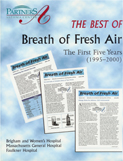Breath of Fresh Air: Feature Articles
Chapter 4: Exercise and Asthma
| It is a well-recognized adage of our modern,
mostly sedentary society that exercise is good for you.
Regular exercise can reduce your risk of heart disease, lower
your cholesterol, help to control your weight, and improve
your body image. But what are the effects of exercise if you
have asthma? Sometimes, exercise can set off your asthma and
cause wheezing, chest tightness, cough, and shortness of
breath. Some persons experience their asthma almost
exclusively when they exercise and are said to have
"exercise-induced asthma." Is it also good for persons with
asthma to exercise? |
Is it true that exercise is good for you even if you have asthma? |
|
|
It has been recognized for hundreds of years that
exercise can bring out asthmatic symptoms. In the last 20
years scientific research into exercise and asthma has shed
light on what it is about exercise that stimulates
narrowing of the bronchial tubes in persons with asthma.
Much of that research was done at the Brigham and Women's
Hospital. It turns out that exercise triggers bronchial narrowing
in asthma by bringing large volumes of air deep into the
chest. When breathing quietly, about one gallon of air
enters the lungs during each minute. The air that enters
the lungs is warmed and has moisture added to it by the
nose and mouth and throat. By the time the air reaches the
bronchial tubes inside the chest, it has nearly the same
temperature and moisture as the walls of the bronchial
tubes themselves. On the other hand, if you run to catch
the bus or to catch a fly ball in baseball, your level of
breathing may double or triple to two or three gallons per
minute or more. Then you exceed the ability of the nose and
mouth to warm and humidify completely the inspired
air. |
Exercise causes more air to be brought onto
the bronchial tubes, needing to be warmed and
humidified. |
|
|
During vigorous exercise, the bronchial tubes themselves are called upon to give up warmth and moisture to the incoming air. In persons with asthma, cooling and drying of the bronchial tubes causes the bronchial muscles to contract, narrowing the air passageways and making it difficult to breathe. You have probably noticed that if you exercise on cold days, you are more likely to set off your asthma than if you perform the same exercise on a warm day. The colder (and drier) the air that you breathe during exercising, the more warmth and moisture the bronchial tubes give up and the greater the stimulus to contraction of the muscles that surround the bronchial tubes. It has long been said that swimming is the best exercise
for persons with asthma, and with good reason. The air that
you breathe while swimming is usually warm and moist and so
the effect of exercise on the breathing tubes is
less. |
In asthma, loss of heat and moisture from
the walls of the bronchial tubes makes them
contract. |
|
|
Wheezing, chest tightness, and cough often come on just
after you stop exercising. If you simply rest, the symptoms
usually go on their own after about 30-60 minutes. If you
use your inhaled bronchodilator, the asthmatic symptoms go
away immediately. Unlike other triggers that set off
asthma, especially allergic triggers like dust and cat
dander, exercise has no lingering effect on the bronchial
tubes. After you have recovered back to normal, there are
no late effects that night or the next day
. |
The effect of asthma on your
breathing usually goes away after 30-60
minutes. |
|
| A variety of strategies work effectively to prevent the symptoms of asthma after exercise. Often on a cold day, you can trap a little bit of warm, moist air in front of your mouth by using a scarf pulled up over your nose and mouth. Face masks are also made for this purpose. For serious athletes, a warm-up period of light exertion helps to reduce symptoms during competition. Medications taken before exercise are effective in blocking asthmatic symptoms. One or two puffs of your beta-agonist bronchodilator (for example, albuterol) inhaled ten minutes before exercise usually prevents exercise-induced asthma. Cromolyn (Intal®) and nedocromil (Tilade®) are also effective when inhaled 15-20 minutes before exercising. | Several strategies can be
used to prevent symptoms of asthma after
exercise. |
|
| Generally, the more active your asthma, the
more susceptible you are to developing symptoms after
exercise. The goal of good asthma care is to keep your asthma
quiet and to allow you to exercise as fully as you wish. As
you know, many Olympic athletes have asthma. Their asthma has
not inhibited their exercise performance, and your asthma
need not limit yours. |
The goal of good asthma care is to keep your
asthma quiet and to allow you to exercise
fully. |

